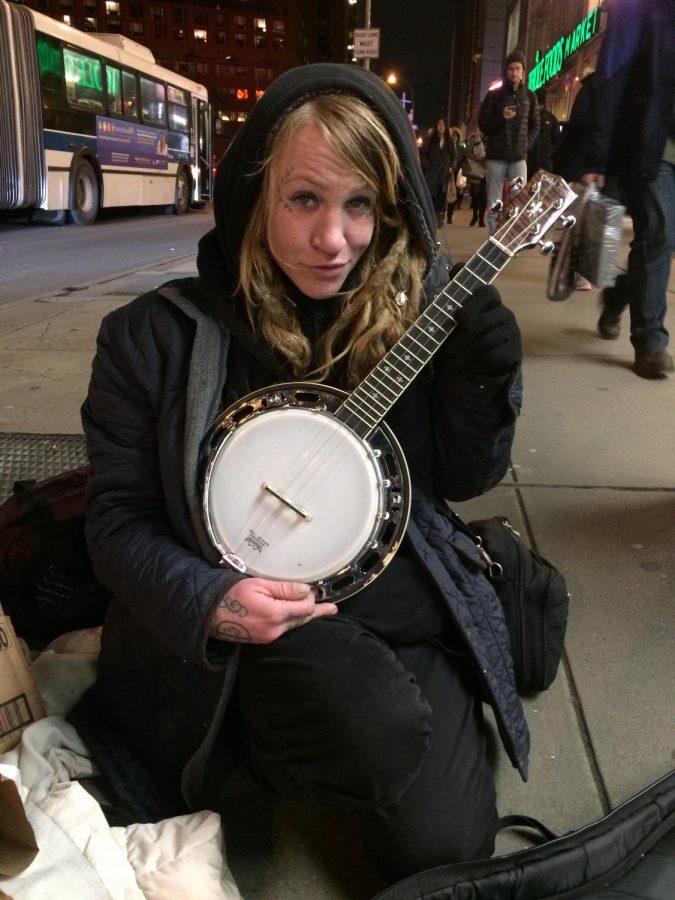In Conversation with the Homeless of Greenwich Village
Kayla, experiencing homelessness in New York City, discusses the issues of living on the streets during the winter.
February 5, 2018
Below-freezing temperatures, snow, rain and numbing winds — January is the most difficult time of year for New York’s homeless.
Winter weather makes living a day-to-day struggle. More often than not, the brutal cold forces people experiencing homelessness to spend their nights in subway trains, where their presence purportedly bothers commuters, and makes the homeless themselves feel deeply unwelcome.
Many wonder why currently homeless people sleep on the streets and in the subways when government-run shelters are available. But it’s not always a viable option, let alone a desirable one.
“I’ve heard a lot more negative than positive things about shelters,” explains Elizabeth, a young woman currently experiencing homelessness and suffering from spastic cerebral palsy living on the streets with her boyfriend, Richard. “If someone has stayed longer and they’ve made friends with the security guards, they have carte blanche to take whatever they want, and the security guard sides with whoever they’ve known, and you can just get kicked out.”
Chris, another man who’s currently homeless, avoids shelters for a much simpler reason — he can’t get in.
“Nine times out of 10, the shelters are backed up,” he said.
But those in the currently homeless population must deal with an array of problems, many of which far outlast the need for warmth on the coldest nights of the year. For many of these individuals, both the most pressing and the most damaging problem they face is that of constant, ruthless stigmatization hurting their chances of getting help from others.
“A lot of people don’t look at homeless people in a humane enough way,” Kayla, a woman who is experiencing homelessness, said. “Sometimes, I almost feel like an animal at the zoo.”
Chris feels like these issues of judgement and stigmatization could be vastly improved by more communication.
“Sometimes, if people took the time to talk to somebody and get to know somebody, then they could understand that there’s much more to a person,” he said.
Ironically, many people experiencing homelessness have noticed that those who treat them with the most empathy — and, similarly, those who contribute the most money or resources — are those who have endured financial trauma themselves.
“A person that can wipe their ass with a $100 bill and fling it out their car window — they won’t give you a nickel,” Kayla said. “But the person with a broken fender and plastic bag and cardboard as their back window … they’re the ones who are gonna give you the last $20 bill, because they know what it’s like to struggle and feel hungry.”
Likewise, despite the struggle of living in the streets, Elizabeth and Richard always try to donate what they can to those in even greater need.
“Even now, with us being homeless ourselves, I always try to give some sort of change or an extra cigarette or whatever I can to other people,” Elizabeth said.
The issue of homelessness is hardly new to New York, nor has it gone unnoticed by the state’s residents and politicians. Yet the trend appears to be worsening. According to the Coalition for the Homeless, the rate of homelessness in New York is at its highest point since the Great Depression, the currently homeless population sleeping in municipal shelters has increased 78 percent in the past 10 years and the issue disproportionately affects African-Americans and Latinos.
Although homelessness remains an issue which affects nearly every urban setting worldwide, New York struggles to take care of its currently homeless population more than its peer cities do. According to Forbes, New York harbors — by far — the highest homeless population of any city in the United States. Despite the city’s struggle in taking care of this part of its population, and despite the harsh reality of living in its streets, thosewho are currently homeless are just as enchanted by the multiculturalism that entrances New York’s residents and visitors alike.
“When I flew back to New York [after hitchhiking around Europe for years], I realized how perfect a city it would be to settle down in,” Kayla said. “Here, I can still, at least, listen to different languages every day; I can go to an Eastern European shelter and buy real, authentic bread.”
In addition to — perhaps, in tandem with — the stigmatization, one of the most pressing challenges homeless people face is the systematic difficulty in improving one’s condition, especially for those who were forced to the streets at a young age and lack the financial and emotional support of a loving family.
“There have been opportunities and loss because of our lack of stability,” Elizabeth said. “There’s only lack of stability because we don’t have the chance to pursue the opportunities, so it’s just a vicious cycle that we’re trying to get out of. Once you get knocked down, it’s really hard, and it takes a really long time, to get back up.”
For many of the people who are currently homeless, it may take several years before they are able to restructure and rebuild their lives. In the short term, their desire for basic human empathy has been elusive so far.
“People as a whole should realize that we all have mothers, brothers, fathers, cousins, uncles and friends,” Kayla said. “That’s all I ask — don’t look at me as that stereotype of a homeless person, and just look at me as a person.”
A Version of this article appeared in the Feb. 5 print edition.
Email Alex Domb at [email protected]

























































































































































